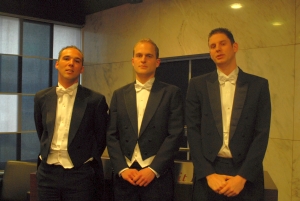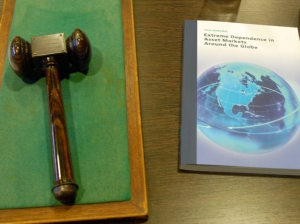Extreme Dependence in Asset Markets Around the Globe
 In the last two decades several major financial crises occurred, including the 1994 Peso crisis, the 1997-1998 Asian crisis, the burst of the internet bubble in 2001-2002, and more recently the 2008-2009 credit crisis. During these financial crises the dependence between asset prices increases to levels exceeding those observed during tranquil periods. Due to this increased dependence, different markets tend to crash together during crises period. This has some important implications for practice.
In the last two decades several major financial crises occurred, including the 1994 Peso crisis, the 1997-1998 Asian crisis, the burst of the internet bubble in 2001-2002, and more recently the 2008-2009 credit crisis. During these financial crises the dependence between asset prices increases to levels exceeding those observed during tranquil periods. Due to this increased dependence, different markets tend to crash together during crises period. This has some important implications for practice.
In his thesis Extreme Dependence in Asset Markets Around the Globe Thijs Markwat shows that the dependence between large stock returns is higher than the dependence between small to moderate stock returns. This is defined as extreme dependence, and it is particularly observed for large negative returns. Therefore, diversification gains calculated from the overall dependence will overestimate the true potential for diversification during turmoil periods. This thesis answers questions on how the dependence between large negative stock returns can appropriately be modelled. The main conclusions of this thesis read that extreme dependence is often present, can become rather strong, should not be ignored, and shows substantial time-variation. More specifically, extreme dependence shows up as contagion, with small local crashes evolving into more severe crashes.
These results indicate that the benefits of diversification to reduce the risk of investing seem to disappear during these crisis periods, when in fact they are needed most. When investors and risk managers have a better knowledge of the dependence during crises periods, they are able to make better allocation decisions and they can get a clearer view of the risks they are bearing.
Thijs Markwat defended his dissertation on March 17, 2011 at Erasmus School of Economics, Erasmus University. His promoter was Prof.dr. Dick van Dijk. His co-promotor was Dr. Erik Kole. Other members of the Doctoral Committee were Prof.dr. C.G. de Vries, Dr. A.J. Patton, and Dr. M.A. van Dijk.
About Thijs Markwat
Thijs Markwat was born in Rotterdam on 26 July, 1982. He obtained his Gymnasium diploma from the Christelijke Scholengemeenschap Johannes Calvijn in 2000. From 2001 to 2006 Thijs studied financial econometrics at the Erasmus University Rotterdam. He obtained his Master's degree with the judicium cum laude. His Master's thesis was based on an internship at Robeco. His thesis was titled Chartists, Fundamentalists, and Trading in Emerging Market Currencies, of which an improved version was published in the Journal of International Money and Finance in 2009. In November 2006 he started as a PhD-student at the Econometric institute (EI) and Erasmus Research Institute of Management (ERIM) at the Erasmus University Rotterdam. During his PhD-track he presented his work at international conferences in Dublin, Washington, Paris, Florence, Singapore and Perth. He also went to Sydney, Australia for a four month research visit at the University of New South Wales (UNSW). The article version of Chapter 2 is published in the Journal of Banking and Finance. After his PhD-track, he started as a Quantitative Researcher at Robeco investment company, with asset allocation as his specific field of interest.
Abstract of Extreme Dependence in Asset Markets Around the Globe
 The dependence between large stock returns is higher than the dependence between small to moderate stock returns. This is defined as extreme dependence, and it is particularly observed for large negative returns. Therefore, diversification gains calculated from the overall dependence will overestimate the true potential for diversification during turmoil periods. This thesis answers questions on how the dependence between large negative stock returns can appropriately be modeled. The main conclusions of this thesis read that extreme dependence is often present, can become rather strong, should not be ignored, and shows substantial time-variation. More specifically, extreme dependence shows up as contagion, with small local crashes evolving into more severe crashes. In addition, due to financial globalization, and emerging market liberalization in particular, extreme dependence between regional stock markets has substantially increased. Furthermore, extreme dependence can vary over time by becoming weaker or stronger, but it can also be subject to structural changes, such as a change from symmetric dependence to asymmetric dependence. Using return data at the highest possible level of detail, improves the accuracy of forecasting joint extreme negative returns. Finally, this thesis shows how different econometric techniques can be used for modeling extreme dependence. The use of copulas for financial data is relatively new. Therefore, a substantial part of this thesis is devoted to new copula models and applications. Other techniques used in this thesis are GARCH, regime-switching, and logit models.
The dependence between large stock returns is higher than the dependence between small to moderate stock returns. This is defined as extreme dependence, and it is particularly observed for large negative returns. Therefore, diversification gains calculated from the overall dependence will overestimate the true potential for diversification during turmoil periods. This thesis answers questions on how the dependence between large negative stock returns can appropriately be modeled. The main conclusions of this thesis read that extreme dependence is often present, can become rather strong, should not be ignored, and shows substantial time-variation. More specifically, extreme dependence shows up as contagion, with small local crashes evolving into more severe crashes. In addition, due to financial globalization, and emerging market liberalization in particular, extreme dependence between regional stock markets has substantially increased. Furthermore, extreme dependence can vary over time by becoming weaker or stronger, but it can also be subject to structural changes, such as a change from symmetric dependence to asymmetric dependence. Using return data at the highest possible level of detail, improves the accuracy of forecasting joint extreme negative returns. Finally, this thesis shows how different econometric techniques can be used for modeling extreme dependence. The use of copulas for financial data is relatively new. Therefore, a substantial part of this thesis is devoted to new copula models and applications. Other techniques used in this thesis are GARCH, regime-switching, and logit models.
View the photo's of Thijs Markwat's defense
Download Extreme Dependence in Asset Markets Around the Globe


